Japan
Wood Products Prices
Dollar Exchange Rates of 25th
April
2021
Japan Yen 108.60
Reports From Japan
New state of emergency ascorona
cases soar
JapanĦħs fresh state of emergency because of a surge in
infections threatens to dash hopes for an early economic
recovery by further weakening consumption. Under the
state of emergency declaration, local authorities will
impose tougher restrictions including the closure of
establishments that serve alcohol, department stores and
shopping malls.
Most of the new coronavirus cases recorded mid-April in
Tokyo and Osaka were variant infections.
Japan/China economies grow closer
Data from the Ministry of Finance shows that imports
from China more than doubled year-on-year in February
marking the biggest rise since 1979 when the data started
being recorded. Analysts say the steady rise in trade
reflects the close economic ties between the two
economies.
Bank of Japan braces to support companies
In its quarterly report the Bank of Japan (BoJ)
downgraded its economic assessments for two of the
countryĦħs nine regions Hokkaido and the northeastern
region of Tohoku where the impact on businesses of the
corona virus has been severe. The assessments for the
seven other regions concluded regional economies are
picking up but the BoJ expressed concerns on the impact
on the service sector. The BOJ indicated a continued
emphasis on providing financial support for companies
and maintaining financial market stability.
In related news the Cabinet Office retained its view that
weakness has been seen in some sectors as consumption
remains subdued due to the continued impact of the
coronavirus pandemic. The Prime Minister has declared a
third state of emergency, effective 25 April to 11 May in
Tokyo as well as the western prefectures of Osaka, Kyoto
and Hyogo. This is an effort to slow the current surge in
infections during the Golden Week holidays, usually one
of the busiest times of the year for travel.
Third state of emergency drives down sentiment
Consumer confidence deteriorated in April according to
the latest Cabinet Office survey as a resurgence of
coronavirus cases led to a third state of emergency for
Tokyo and several other areas
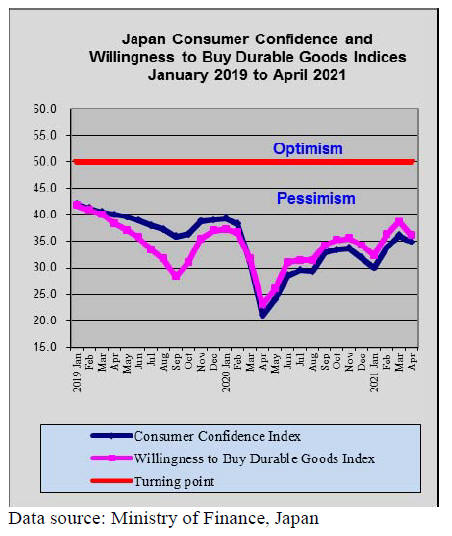
Yen strengthens slightly
At the start of the second quarter 2021 the Japanese Yen
began reversing weakness seen in the first quarter when
there was a steady downward direction in the yen/dollar
exchange rate but now just four weeks into Q2 that trend
has come undone and the yen has begun strengthening
rising to around 107 to the dollar at the end of April.
The US dollar lost steam following the latest policy
statement from the Federal Reserve (Fed) which reflected
on rising commodity prices and a hint of inflation. But,
looking ahead it is only when full US employment is
approaching that the Fed will be inclined to change its
stance.
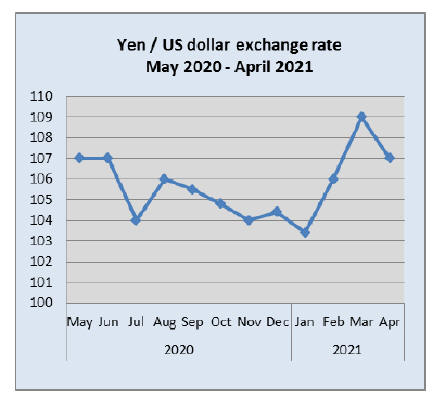
Shortages and rising prices plague home
builders
House builders in Japan have been affected by rising
prices for sawnwood imports from the US the result of
supply limitations and the strong US market for homes
(see page 13). The construction industry in North America
is also reeling from solid wood construction framing
building material prices that continue to soar. The impact
of the rising prices and delayed shipments of sanweood
from the US has prompted Japanese house builders to alert
clients that there may be delays in completion.
March 2021 housing starts were up compared to levels in
February but total first quarter starts are about the same
level as in 2020 at the beginning of the pandemaic and are
around 10% down from the first quarter 2019.

Import update
Furniture imports
The trend in JapanĦħs furniture imports over the 12 months
to February 2021 is illustrated below. Remarkeably
domestic sales of furniture have been sustained which has
encouraged imports even to the point of boosting imports
between May 2020 and February this year. In particular
imports of bedroom furniture have been rising since the
beginning of the third quarter of 2020.
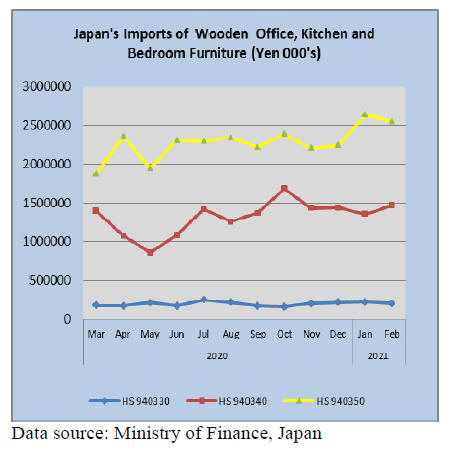
Office furniture imports (HS 940330)
After 3 months of steady increases the value of JapanĦħs
imports of wooden office furniture saw a correction in
February this with imports dipping around 10% from the
level in January. The rise in imports corresponded with the
work from home business operation. If the value of
imports flattens over the next few months then it would
seem consumers have completed their refurbishing to
create home work space.
As in previous months shippers in China dominated
JapanĦħs wooden office furniture imports in February
accounting for 78% of all HS940330 imports but this was
almost 13% down from January. The other two main
shippers in February were Taiwan P.o.C and Vietnam.
Shipments from Taiwan P.o.C jumped 5 fold but, as was
the case for Vietnam, accounted for just 5% of the value of
HS940330 imports.
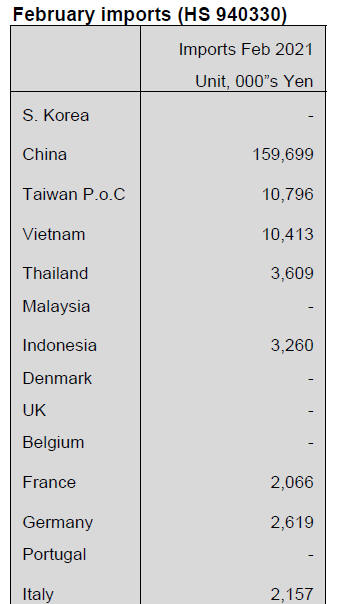 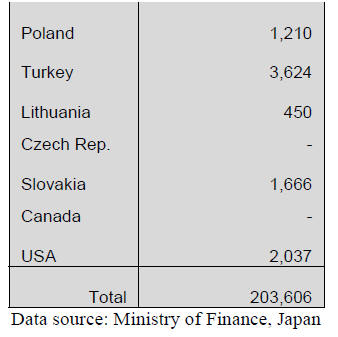
Kitchen furniture imports (HS 940340)
Year on year the value of JapanĦħs imports of wooden
kitchen furniture in February this year jumped almost 20%
and compared to arrivals in January 2020 there was an 8%
increase.
Manufacturers in three countries, the Philippines, Vietnam
and China continue to capture almost all of the demand in
Japan for imported wooden kitchen furniture. February
2021 imports from the Philippines accounted for 41% of
imports with shippers in Vietnam taking a 35% share,
China followed with a 14% share.
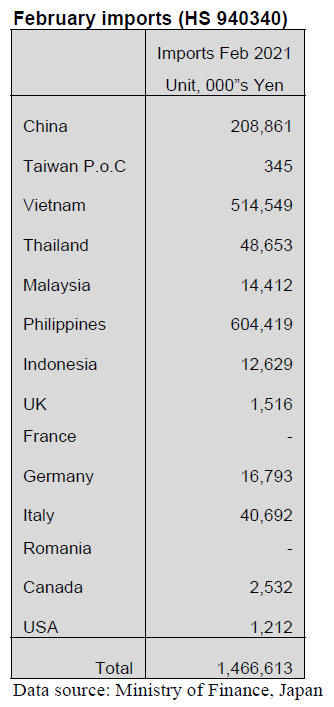
Bedroom furniture imports (HS 940350)
After 2 months of substaintial increases the value of
JapanĦħs imports of wooden bedroom furniture corrected in
February this year dipping slightly.
Imports from the top two shippers, China and Vietnam
were little changed from a month earlier with exporters in
China accounting for almost 60% of all HS940350 imports
and another 35% arriving from Vietnam which indicates it
was the other small shippers that saw most of the decline
in February, the exception being Malaysia where exporters
of wooden bedroom furniture achieved a 20% increase.

Trade news from the Japan Lumber Reports (JLR)
The Japan Lumber Reports (JLR), a subscription trade
journal published every two weeks in English, is
generously allowing the ITTO Tropical Timber Market
Report to reproduce news on the Japanese market
precisely as it appears in the JLR.
For the JLR report please see:
https://jfpj.jp/japan_lumber_reports/
Frantic search for substitute materials
Precutting plants are now unable to purchase necessary
building materials they have been using such as North
American and European products after supply sources
reduced supply volume and shortage of containers causes
delay of arrivals of ordered items.
Precutting plants are now looking for substituting
materials desperately but they are not easy to find.
To replace imported laminated products, orders are
rushing to domestic laminated lumber manufacturers but
they are short of lamina from Europe so replacement is not
easy. Naturally the prices of all items continue climbing. If
shortage of necessary materials continues, many precutting
plants will be forced to stop the operations in May.
Precutting plants are asking dealers and importers to find
replacing materials by all means.
Housing companies are not well aware of this situation
and stick to the materials they have been using, which
perplexes precutting plants.
There is no European redwood laminated beam in
distribution channels and the prices in April will be 65,000
yen from 58,000 yen in March, 12% jump in one month
then the second quarter prices would be over 70,000 yen.
KD Douglas fir beam prices are about 60,000 yen but
availability is limited and the prices would further
advance. Whitewood laminated post prices are about 1,900
yen per piece delivered on both imported and domestic
made products in March but after April, the prices are
2,100 yen. Domestic cedar laminated post prices shot up
by 4,000 yen in March and now 52,000-53,000 yen per
cbm delivered.
Whitewood stud supply is very tight and search for
substitution gets heated up. KD cedar supply dried up and
LVL of cedar, Chinese poplar and New Zealand radiate
pine started coming into the market.
Prices of whitewood KD stud in March are 55,000 yen per
cbm delivered and KD cedar stud are 50,000- 55,000 yen.
Small Douglas fir side-cut lumber prices are over 70,000
yen, 3,000-4,000 yen up from February but the supply is
skimpy and substituting domestic cedar lumber supply is
delayed since sawmills carry too much orders.
Overseas inflation is squarely hitting Japan market.
Daishin Plywood quit operation
Daishin Plywood Co., Ltd. (Niigata prefecture) stopped
the operation at the end of March after 55 yearĦħs plywood
manufacturing. Daishin Plywood started in 1965 as
Niigata plant of Sunamachi Veneer in Tokyo. This is the
last major tropical hardwood plywood manufacturing plant
in Japan.
Facing declining resource of tropical hardwood logs with
export restrictions and climbing log prices, it gave up the
business and has been preparing to withdraw from
plywood business since 2020 and notified the customers.
In 2020, the production was 3,800 cbms a month and it
finished the operation in last February and log inventory is
totally consumed. It has been preparing to sell the property
and machines since last year.
The president say that future outlook became uncertain
after Sabah, Malaysia banned log export in 2018 then
PNG increased log export duty.
The company was well known to manufacture particular
size plywood the customersĦħ demand.
Plywood
plywood is getting active since middle of March after
quiet February. It is hard to see future movement since
large precutting plants have started restricting taking
orders because of shortage of wood products such as
structural laminated lumber and stud.
Domestic plywood manufacturersĦħ inventory remains
tight. It is about 0.4 month so produced plywood is
shipped immediately. By earthquake on March 22 off
Miyagi coast, some plywood mills suffer fire damage so
that the production would decrease so precutting plants
hurry procuring plywood. Tight supply of tropical
hardwood imported plywood continues.
It is about time that rainy season is over and log
production gets active but this year, rainy season is
prolonging then labor shortage caused by moving
restriction by COVID 19 so local plywood mills struggle
to secure logs. Also mill workers are short by the same
reason so plywood mills have hard time to satisfy orders.
In Japan, the inventory continues diminishing week after
week. In particular, Indonesian plywood is getting tight so
the dealers are chasing remaining inventory and the prices
are firming particularly coated concrete forming panels.
Domestic logs and lumber
Replacing demand for tight supplied North American and
European wood products to domestic products spurted
rapidly since middle of March so the supply gets tight and
the prices are climbing particularly demand strong Kanto
region.
Log production is steady and normally it is time that log
prices weaken by over supply but sawmills are
aggressively procuring logs to catch up substituting
demand so log prices are firming.
At first short supplied Douglas fir lumber demand shifted
to European redwood and whitewood but after European
supply gets tight, demand shifted to domestic wood in
March. Orders are busy on not only smaller stud and brace
but larger sill, purlin and post. Some demand is
speculative since future prices get higher by increasing
substituting demand.
Japan Kenzai made demand forecast
materials dealers, made survey through 3,000 customers
by internet as to demand forecast. The demand has been
improving after the bottom of the second quarter 2020 but
severe situation continues. It is comparison to the same
period of last year.
The survey is made by indicating increase, slight increase,
unchanged, slight decline and decrease compared to the
same period of last year and responders select one of five
categories. Demand outlook by contractors for the second
quarter is minus 34.5 points.
He first quarter outlook was minus 46 points so it is
improving but still minus outlook continues. DistributorsĦħ
outlook is minus 38 points, improved from last surveyĦħs
48.5 points.
For building materials manufacturers, demand increase is
forecasted on plywood, wood building materials, ceramic
products and house appliances but plywood and house
appliances remain the same as last year but ceramic and
insulation products show 53% indicates declining forecast.
Influence of COVID 19 is becoming smaller but more than
60% forecast close down or bankruptcy of customers so
future continues foggy. For renovation works, there are
more new life style renovation with more than 2.5 million
yen.
CLT promotion meeting
11 th meeting among related Ministries was held to
discuss use of CLT and to make up road map to expand
the market of CLT. The new road map picked up problems
from past road map, which are degree of recognition of
CLT, advantage of market prices, timely supply to meet
the demand, area CLT can cover, designer and operator
and means of maintenance and management. These
problems should be solved and should show means to
improve.
Concrete plans include use of CLT at large events,
contribution to investment for SDG and ESG,
standardization of sizes by unifying individual
manufacturers, development of low cost joint, establishing
stable supply system by unifying manufacturers.
Target is to establish CLT production system of 500 M
cbms a year and reduce the cost down to 70,000-80,000
yen per cbm. As to recognition, first is to let construction
industry know since CLT is not yet well acknowledged
and to promote use of CLT for medium high stories
buildings like four to five stories.
Based on the past road map, the meeting reported that total
of 550 units of CLT buildings have been built at least one
in every prefecture.
|